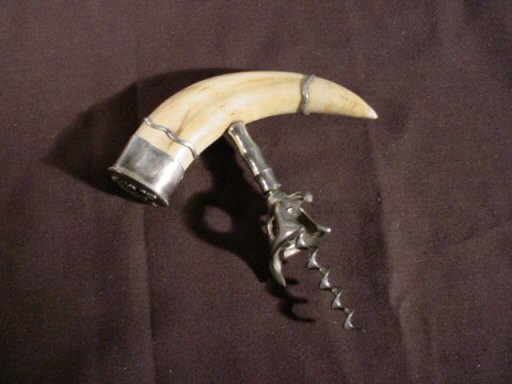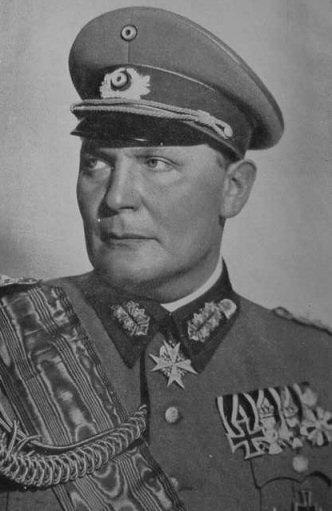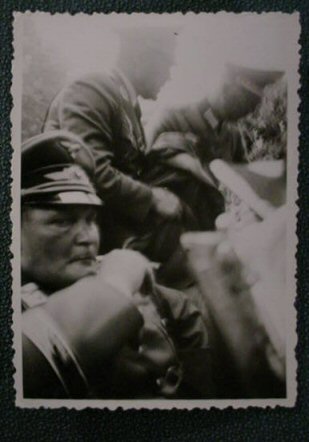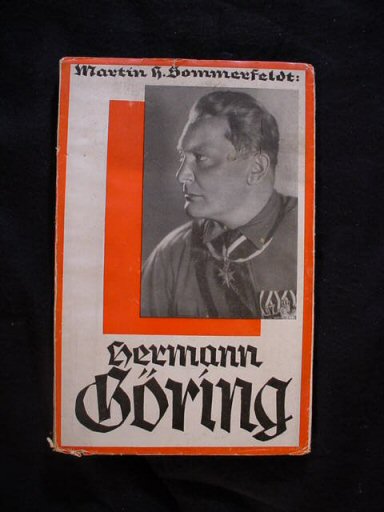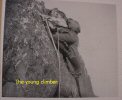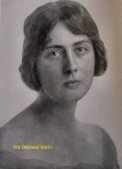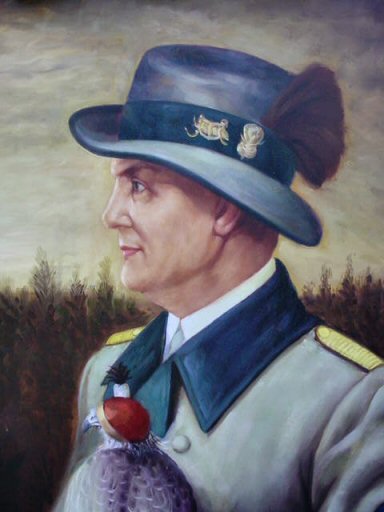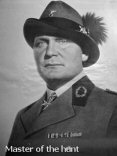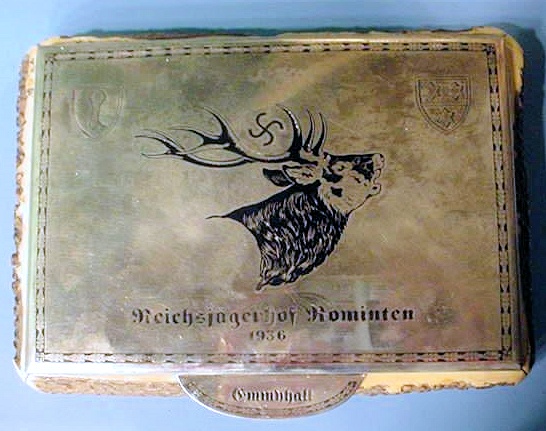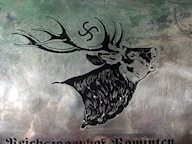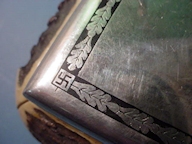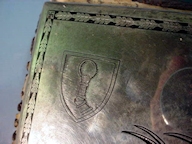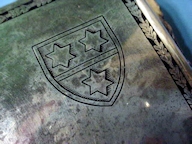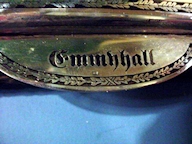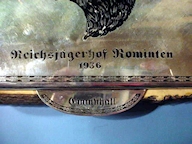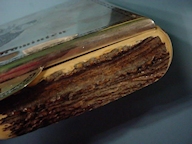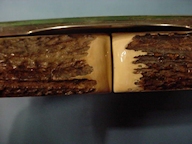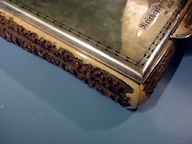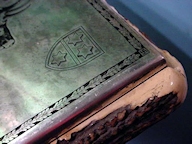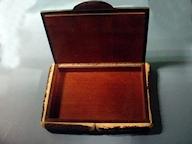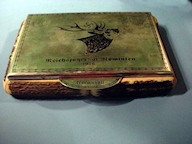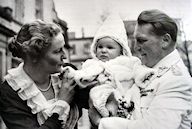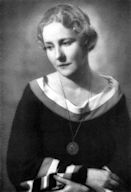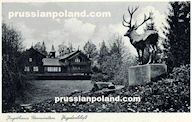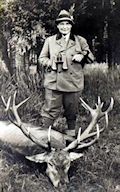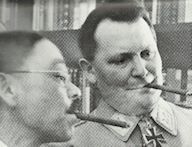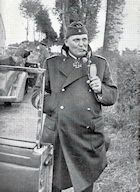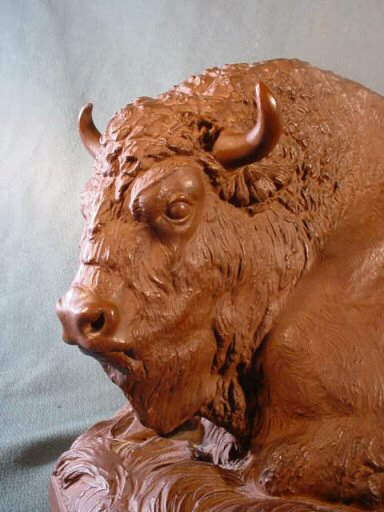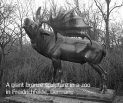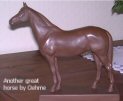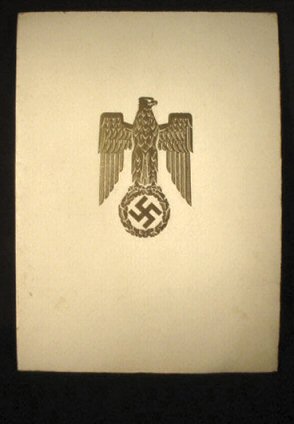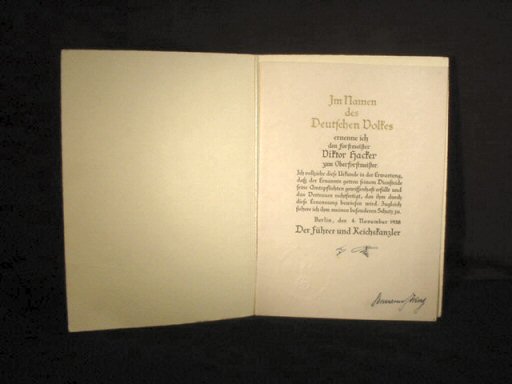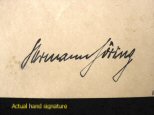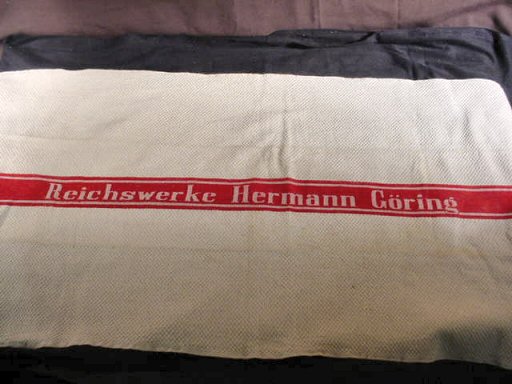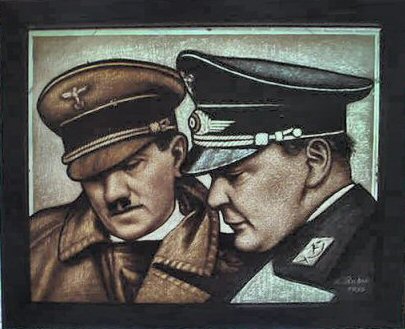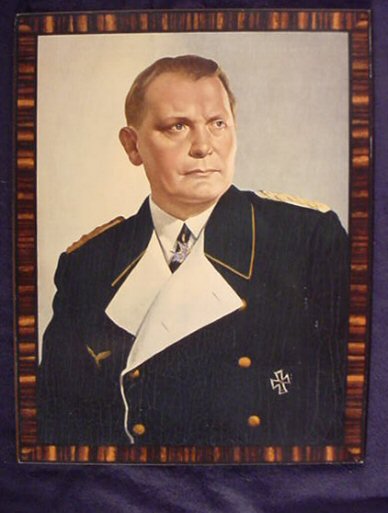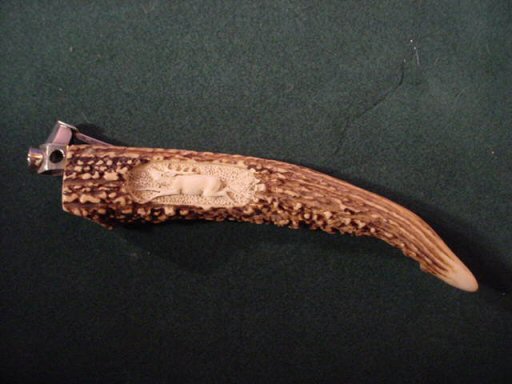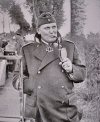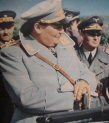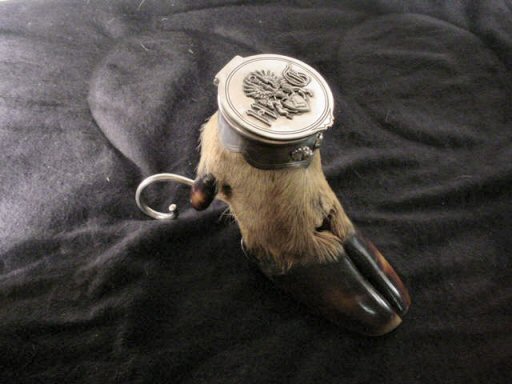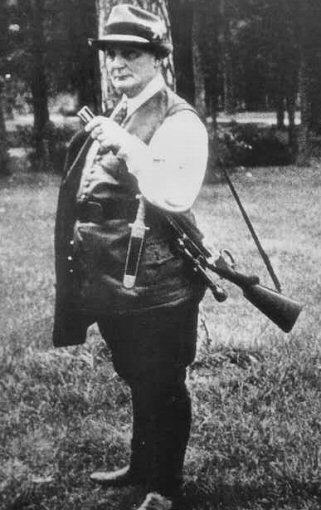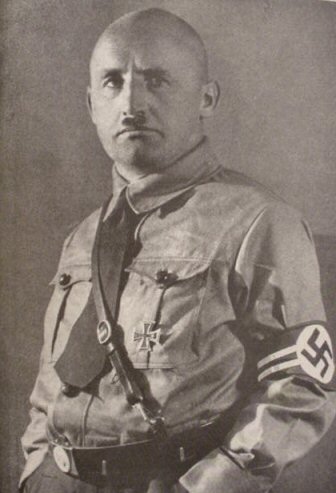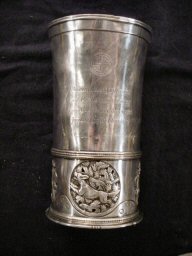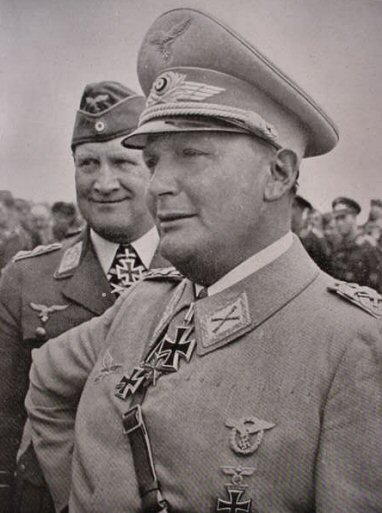|
|
|
|
Hermann Göring
Page 8
|
|
|
|||||||||||
|
Corkscrew from Carinhalle (Hermann Göring) (Item GOR 8-1) |
|||||||||||
| DESCRIPTION: Made from a boar’s tusk this was the typical Göringesque implement. Marked with moon, crown, and ‘800’ silver designation, it also bears upon its cap the Göring family’s coat of arms and the ‘H.G.’ all in fine silver. The silver bands around the tusk give the whole corkscrew its Wagnerian-Teutonic countenance. This came out of the same purchase as the other items in the Göring Treasure Trove section.
PRICE:No longer available. |
|
||
|
Snapshot of Göring (Item GOR 8-2) |
||
| DESCRIPTION: Here is a snapshot picture of Hermann Göring taken by an old veteran of the German Army who is known to us. It is very rare to see a candid photo taken this close up with a small, Leica camera. Although small—2 1/4 x 3 1/4 inches—it is ultra-rare. Göring is seated in his staff car with his Luftwaffe driver and an army officer of the security services of Das Heer. This was taken under a very unusual and humorous circumstance. Göring was intending to enter an army base that was on high security alert and the security guard asked to see his papers. The driver exclaimed, “Do you not see who this is? This is the Reichs Marshal Göring!” You can see the look of consternation and anger on the face of Unser Hermann. Our veteran snapped this close-up at the height of the argument. This is a one-of-a-kind item with a great history!
PRICE:$125.00; 100 percent original |
|
||||||||||||
|
Göring Master of the Hunt Silver Medallion (Goetz) (Item GOR 8-3) |
||||||||||||
| DESCRIPTION: This is a silver medallion by the master medalist Karl-x-Goetz.. Goetz was born in Augsburg, Germany. He studied art in that city under master Johannes Dominal and continued his education in Dresden, Leipzig, and Berlin until 1897, after spending 2 years in The Netherlands, and Paris for 5 more years. He finally settled in Munich where he spent the rest of his life. He extended his sculpting and medalist abilities in the creation of pattern coins for the German Kaiserreich and the Welmar Republic in the 1930s and 1940s. He produced many medallions for the National Socialist government under Hitler. He won many awards and prizes throughout his career. An entire history of Germany through all it tribulations and glory can be perceived in the fine medals of Karl Goetz. This medallion of Reichsmarschall Hermann Wilhelm Göring is possibly one of Goetz’s best. Göring is seen in his Jäger hat with the date ‘1935’ and the words Reichs Jägermeister Hermann Göring (Reichs Master of the Hunt). On the back is a downed stag with an owl on a stone pedestal. The owl was a symbol of the hunt engendered by natural wildwood wisdom. On the pedestal are the words: “Für Natur Schutz,” “For protection of nature.” Göring certainly was for this! As Reichs Jägermeister he was the ecologist’s ecologist. See our write-up on him at the Göring Ring at Item GOR 5-1 and the Rustic Lodge Chest at Item GOR 7-2. Even his enemies credit him with great services to hunting and forestry measures that are still used effectively today. The medallion is silver-dollar sized and is beautifully struck in great detail. Our elderly jeweler struck about 10 of these all in silver and his son told us they were never actually delivered to the offices of the hunting association. So we were able to purchase all ten of them. For some explanation of how we came into these and so many other silver items, see the section “About Our Rings". This is a fine rendering of a really great Goetz medal. Our jeweler knew Karl Goetz personally as a close friend.
PRICE: SOLD |
|
||||||||||
|
Book Herman Göring (Item GOR 8-4; PERS 2-11) |
||||||||||
| DESCRIPTION: This is a soft-cover, small book that is a capsule review of the likes of the man who historians have dubbed the latter-day Falstaff; the flamboyant, colorful, brave, and loyal Hermann Göring; general, SA leader, chief forestry official, WWI ace, Reichsmarschal, etc. This was the human dynamo, probably the most energetic leader of the 20th century. Loved by his German people and called Unser Hermann (our Hermann) here was a man who made mincemeat out of his cowardly accusers at the trails at Nuremberg, Jackson was no match for this forceful and courageous word warrior; well, that’s another story!!! This book contains 76 pages and only about 8 pictures and is a valuable relic as an archival item of importance.
PRICE: $125.00 |
|
||||||||||||||
|
Painting of Hermann Göring as Reichsjägermeister (Item GOR 8-5) |
||||||||||||||
| DESCRIPTION: Here is a magnificent picture of Reichsmarschal Hermann Göring in his uniform as the Reichsjägermeister, Master of the Hunt. To find out more on this title please refer to our other narrations on Göring at Items GOR 7-1 and GOR 7-4. The picture in oils measures 4 feet x 3 feet and is done by a master artist in Germany. It is taken from the original that has shown up in the U.S. and has been displayed at the ‘Max Show’ and the Louisville ‘Show of Shows.’ The likeness to the original is spectacular, but what this one has and the original does not is the fantastic antler-art frame. This frame is a period production dating in the 1930s and was originally in a Jagdhalle (hunting lodge) in east Prussia. We bought this frame years ago and saved it for something like this and the wait was worth it for this painting couldn’t be more appropriate for this magnificent frame. The master of the hunt is seen here with a hunting falcon that is depicted with the traditional and necessary hood. Göring wears on his arm the patch of the Deutscher Jäger association that he founded. The face, clothing, and colors are great and this would be just the ticket for a hunting collection or great for the centerpiece of a general WWII German assemblage of important relics that might lean to the artistic.
PRICE: $2,500.00; the frame alone is worth more than half the price |
|
|
|
Cigar Box from Hermann Göring’s Hunting Lodge (Item GOR 8-5a) |
|
DESCRIPTION: We know that ‘Unser Hermann,” as the German populace called him, loved a good cigar. To the German Reichsmarschall it was just part of the opulent life style he had created for himself in the German Third
Reich that he worked so diligently to create along with his Führer Adolf Hitler. Göring was given the title of Reichsjägermeister (the nation’s Chief Hunter), an office he held the most dear of all his many responsible positions, and as the nation’s Chief Hunter and Forest manager he took every opportunity to don his hunting togs and enter once more the sacred forest of the Schorfheide where his home and hunting lodges were located. He hunted elk, bison, moose, boar, and numerous other game animals and he founded the Deutsches Tierschutzgesetz, the law against cruelty to animals. He was the all-consuming sportsman. While also being enveloped in serious matters of state and as the Chief of the German Air force (Luftwaffe), he probably was the busiest high-ranking official in all of Europe during the time of struggle (Kampzeit) and after the NSDAP Machtergreifung (ascension to power). He was beloved by the German people and cries of ‘’Our Hermann” went up loudly when he was seen at reviews and public celebrations. His magnificent villa or mansion in the Schorfheide Forest was named after his first wife Carin, who was Swedish. They were married in January of 1923, and his love for her was wonderfully sincere and boundless. Sadly, she died from heart failure October 17, 1931, and Göring’s palatial home in the forest was named Carinhall. It was built in Carin’s honor and it was there that he had her body reinterred from her grave in Sweden. He had her buried in a crypt at the baronial estate and filled Carinhall with images of Carin whom he loved so solemnly until the day he died by suicide in a cell in Nuremberg. In 1935, Hermann married Emma “Emmy” Sonnemann and had built for her a magnificent hunting lodge in the Rominten Heide and named it “Emmyhall” after this elegant lady. Hermann Göring possibly spent more happy hours at this lodge than at the grand villa Carinhall and we attribute that to the fact that he was the consummate hunter and the sport was his chief relaxation from the heavy and huge burden of state service. He also kept a great part of his collection of swords, daggers, and firearms here at this hunting lodge in Rominten Heath. Emmy also spent a great deal of time here in the lodge that bore her name and later little Edda Göring loved it there and found it to be more ‘homey’ than the beautiful but grandiose Carinhall. Many sportsmen among Göring’s visitors were invited for weekend hunting expeditions at Rominten, but none turned out to be a better marksman with rifle or bow and arrow than the Reichsmarschall, himself—he was always the absolute best! The Cigar Case This is a fabulously beautiful storage case for the finest of Cuban cigars that were enjoyed by Hermann and his guests. It sat on his desk in his personal office. He had other repositories for his precious cigars, but this is the one that was closest at hand for his pleasure. Göring also smoked a long, traditional Bavarian pipe, but the cigars were his favorite treat. The case that we offer here was bought several years ago at an auction in Germany. It had been in the possession of one of Göring’s favorite forest wardens who removed it from Emmyhall when the Reichsmarshal had to flee from the wrath of the Russians who were fast approaching East Prussia and the Schorfheide. Göring had left long before this to manage his Luftwaffe in the “Widerstand,” or “last resistance.” And now the world was about to change for the worst! The case is beautifully hand engraved in the finest artistic manner. It was probably a gift from some German or foreign official. It has the crest of Hermann Göring up at the topmost corner while Emmy’s family crest is seen on the right-top corner. An elk is seen in the middle of the box with a mobile swastika between its antlers. This is a take-off of the Saint Hubertus legend so favored by both Göring and Hitler. You can find explanations of that Germanic saga in several places on our site. Below the elk is engraved the legend "Reichsjägerhof Rominten 1936." On the lip that would be lifted to display the cigars it says “Emmyhall.” All around the edges of the case are finely engraved oak leaves. Each is individually hand engraved. There are 75 of them, and at each corner you can see stationary swastikas also engraved. The box measures 9 x 7 inches including the “Emmyhall” lift tab. It is 1 3/4 inches deep. Six panels composed of cleverly placed elk-horn cuttings for maximum rustic artistic beauty support the sides. The inside seems to be cedar lined to preserve the freshness of the cigars within. This is what we call a Göring relic extraordinaire—not only beautiful, but extremely historically important. PRICE: $12,500.00 |
|
|||||||||||||
|
Meissen Bison by Oehme (Item GOR 8-6; ART 10-9) |
|||||||||||||
| DESCRIPTION: This is utterly magnificent. Here, by the famous Meissen artist Eric Oehme, is a buffalo (bison). Many people think the bison is strictly an American-based animal, but contrary to this opinion, the bison roamed all through northern Europe. Hermann Göring raised these magnificent beasts on a ranch near Carinhalle, his estate in the forest of the Schorfheide. It is thought that bison came to North America during the Peistocene Epoch via the Bering land bridge, but they originated in their present form in Europe. European bison, Bison bonasus, once roamed the great temperate deciduous forest that stretched from the British Isles through most of Europe and into Siberia. Though time has taken its toll on the continuous distribution of bison, which now exist in a few isolated areas, it is fortunate that ecologists like Göring were able to preserve the species through responsible stewardship of specific hunting ranges and wildlife shelters. Many of the breeding stock for Göring’s buffalo came from the ranch at Bialowieza in Poland, where some of the finest of the breed were raised. The Europeans have always been enamored and enthralled with the huge beast and many paintings and sculptures of note have been executed over the years. Such is the case with the sculpture we offer here. The piece was created by Erich Oehme, who was a specialist in the brown clay that was used for many special Meissen figurines. This was called Böttgersteinzeug. The formula for this clay was discovered by Johann Fredrich Böttger, the man who is credited for being the first in Europe to discover the secret of hard-paste porcelain in 1709. The quality of this special brown clay provides for a soft, glowing finish with excellent molded detail. This medium saw a revival of interest during the period of the Third Reich and Herr Oehme was the leading exponent of this wonderful artistic expression. Eric Oehme was born in Neuberthelsdorf in 1889 and died in 1970. He studied at the Academy of Fine Arts in Dresden since 1913 as a modeler (sculptor). He named this bison (his most famous work) ”Wisent Cow Sonja.” On our pages you will see other Erich Oehme porcelains and in our thumbnails above you will see other magnificent pieces that he created. Of particular note is the wonderful SS sculpture at Item SS 7-4. This is called “Die Alarm.” The other was a similar group by the same name depicting SA Storm Troopers in the same pose. The Third Reich art by Oehme is also represented by a great Böttger plaque depicting the bust of Adolf Hitler at Item AH 16-1. Also, see the Meissen plaque commemorating the Austrian Anschluss at Item GEN 7-9. Item ART 10-7 depicts the Aryan Teutonic man in the struggle against Bolshevism. There is no doubt that this amazing artist was to be considered one of the greatest Third Reich-period creative sculptors; perhaps, never reaching the status of Thorack or Brecker, but nonetheless, famous in his own right. This buffalo is one of his greatest achievements and we are markedly proud to offer this and other Oehme masterpieces. This particular piece was owned by Reichsmarschal Hermann Göring, who, like Goebbels, with “Alarm,” had it specially ordered. The value we place on this very special art masterpiece does not reflect Hermann’s ownership, even though it came from Veldenstein, the Göring castle. The piece stands on its own in value. In perfect condition it measures 16 x 9 inches across its base and from the bottom of the base to the highest point of the animal’s hump is 10 inches. This truly is a museum piece extraordinary. It has all the proper Meissen marks for the period. Here is a chance to own one of the very finest of Third Reich period art.
PRICE: SOLD |
|
|||||||||||
Promotion Document Signed by Göring in 1938 (Item GOR 8-7; HUNT 6-11) |
|||||||||||
| DESCRIPTION: This is an official promotion to the Forest Master Hacter to Chief Forest Master, Oberforstmeister, in Berlin on November 4, 1938. It has the facsimile signature of the Führer and Reichskanzler Adolf Hitler and the embossed oak-wreath-surrounded national eagle. The document is signed (by hand) by the Reichsforstmeister, himself, Hermann Göring. This is definitely a true signature. The document is encased in a heavy manila folder with the Reichsadler (eagle) embossed on its cover; similar to the way a Knight’s Cross document is done. The folder measures 14 1/2 x 10 1/2 inches and is in A1 condition. This is a rare and important document.
PRICE: SOLD |
|
|||||||||
Towel from the Hermann Göring Werke (Item GOR 8-8) |
|||||||||
| DESCRIPTION: This is a towel from the famous Reichswerke Hermann Göring. This factory was established in 1937 by the German leader in his capacity as the most senior official responsible for the Four Year Plan. This revolutionary concept resulted in not only a steel mill, but it engaged in a great many activities including machine-tool engineering and shipping. The main purpose of experimental projects at the Werke was to lessen Germany’s dependency on iron ore imported from abroad. In a way, Göring could be realistically called sort of a Nazi Henry Ford because his leadership efforts were supported by contribution of capital by German steel barons. The cotton-based towel is about 13 x 17 inches and is in great condition. This is a fine souvenir of a time of human advancement personified by a tireless and dedicated leader of people and state, Hermann Wilhelm Göring.
PRICE: $295.00 |
|
|||||
|
Fensterglas depicting Adolf Hitler and Hermann Göring (Item GOR 8-9; AH 20-2; ART 13-10) |
|||||
| DESCRIPTION: Here is a very rare Fensterglas, or window hanging, in hand-painted glass. This is done with a process of painting on top of the glass and reverse, as well (a true German art form). This depicts the Führer and the Reichsmarschal as they go over battle maps and plans together. It is beautifully done and measures 11 x 9 inches in its oak frame. The glass itself is 9 3/4 x 7 3/4 inches and is in wonderful condition and a real art rarity.
PRICE: WITHDRAWN |
|
||||||
|
Wood-based Print of Hermann Göring as Air Marshal (Item GOR 8-10; LUFT 14-15) |
||||||
| DESCRIPTION: This wonderful print on board is done in what appears to the casual observer to be marquetry. It’s in 100 percent great shape and measures 9 x 11 1/2 inches. It depicts the marshal in his blue Luftwaffe tunic with Iron Cross and Pour le Mérite (Blue Max). Göring chalked up 22 kills in WWI making him an ace and when the noble Manfred v. Richthoffen was killed, Göring was then the chief of the Richthoffen Flying Circus. He had an illustrious career both as WWI hero and as the man who built the modern Luftwaffe from a bunch of gliders to the mightiest air arm the world had ever seen. This rare art piece is really a match for the Adolf Hitler piece at Item AH 13-2. This study of the man called the “latter-day Falstaff’ because of his patronage and love of art and culture seems to reflect the nobility of this man who as the German populace called “Unser Hermann,” “our Hermann.”
PRICE: $945.00 |
|
|||||||||||||
|
Carved Cigar Cutter (Item GOR 8-11; HUNT 7-11) |
|||||||||||||
| DESCRIPTION: Here is one of the articles that have turned up in the area of Veldenstein, the castle that belonged to Hermann Göring’s adopted godfather, Hermann Ritter von Epenstein, a Christian of Jewish descent. Often it is said that the name Hermann was given to Göring to honor Arminius, who defeated the Roman legions at the Battle of the Teutoberg Forest. Hermann is the German name for Arminius; however, the name was far more likely chosen to honor his godfather von Epenstein. The young Göring admired—even worshipped—the older man. Ritter v. Epenstein sought always the trappings of the German aristocracy as well as the titles, thus setting the pace for his adopted godson. Hermann Göring tried to emulate the old knight in his every idiosyncrasy. Göring was partly raised and spent much of his childhood in the Ritter’s two magnificent castles: Burg Veldenstein in Bavaria, and Schloss Mauterndorf near Salzburg, Austria. Both castles were to be residences to the Göring family, their official caretakers until 1931, and both were tremendous influences on Göring’s childhood and fascination with military and romanticized notions of Germanic history. Both castles were also ultimately to be his property. Late in life Ritter v. Epenstein wed a singer, Lily, who was half his age bequeathing her his estate in his will, but requesting that she in turn bequeath the castles to his godson, Hermann, upon her own death. Göring often visited both Veldenstein and Mauterndorf during the 1930s and lived there part of the time all the way up into 1945. When it was obvious that the war was lost he shipped much of his treasures from Carinhalle and Romertin to Veldenstein. Göring hoped that a just reconciliation between the belligerent powers could be reached, and that his castles would be treated as private property, and he would be treated as a head of state and dealt with as the rules of civilized warfare dictate. This of course was not to be with haters such as Eisenhower and Churchill involved. So the castles obviously were to be robbed and sacked. Knowing this to be imminent the townspeople in the vicinities immediately upon the dismissal of the Luftwaffe guards descended upon the castles and stripped them bare of the articles that belonged to the Reichsmarschal, whom they still reverently referred to as “Unser Hermann,” and who can blame them? Why should they not do all in their power to save these priceless relics from the clutches of Ivan or GI Joe six pack? So here we have one of the art pieces that was “liberated” from Burg Veldenstein (thank goodness). We have negotiated several wonderful items from three families in the castles’ vicinity and one family that has a few things have introduced us to others and this is how we have been able to procure some significant items. This cigar cutter, however, is one of the most significant of all and quite gorgeous to boot. The carvings seen on the antler are very well executed and professional. It must have been one of the many such gifts bestowed upon him by an adoring public. The antler is about 10 1/2 inches long and is probably the tip of a huge rack from an elk. The one side shows such an elk in flight from the hunter’s gun. On the other side is a magnificent, carved German eagle presented in the style of the Reichsmarschal eagle minus the crossed batons. This eagle surmounts the “H.G.” initials. The carving is absolutely superb and stands out from the antler in exquisite detail and artistic perfection. It is a perfect example of the carving skills of the German folk. The cutting tool at the end is marked with a stamp and company logo. Göring and Heinrich Himmler were both smokers to the disdain of Hitler, who abhorred smoking. Goring is seen in pictures enjoying Cuban cigars and we have a cigar box of the Reichsmarschal’s favorite cigar at Item GOR 6-2. While in there you should read all the other write-ups about this phenomenon of our times. He truly was the modern-day Falstaff.
PRICE: NO LONGER AVAILABLE |
|
||||||||||||||||||||||
|
Magnificent Inkwell from Castle Veldenstein (Item GOR 8-11a) |
||||||||||||||||||||||
| DESCRIPTION: Here is an inkwell that is so typical of the personal effects of Hermann Göring. It was not doubt part of the items from Carinhalle, the Grand Villa, or the hunting lodge at Rominten. We have explained above in Item GOR 8-10 about the transfer of the Göring treasures. This inkwell is crafted from an elk’s foot; probably one of the Reichsmarschal’s hunting trophies. The full Göring crest is adhered to the cover. All the metalwork is in pure silver. It is, of course, defined with the winged arm with ring, the deer, and lion. The deer is in the Saint Hubertus style with swastika between the antlers. The initials “H.G.” surround the crest. The hallmarks and silver designation are found on the inside rim of the cover. A small iridescent blue well is also found when the cover is opened. Oak leaves and acorns adorn the frame that the cover shuts upon. This is what we would consider the ultimate in Göring relics—beautiful and historically important. This would be the “key piece” in any Hermann Göring collection, or fine Third Reich accumulation. It’s absolutely wonderful!
PRICE: SOLD |
|
||||||||||||||||||||||||||
|
Silver Goblet; a Gift from Julius Streicher (Item GOR 8-14; SPECIAL SALE SECTION) |
||||||||||||||||||||||||||
| DESCRIPTION: This is a beautiful silver Pokal, or Goblet, that is a typical Nuremberg-style with Frankish motif throughout. It was presented to Hermann Göring by Julius Streicher, Gauleiter of Franklin, in 1934, to commemorate a major hunting expedition in the woods surrounding Nuremberg arranged by Streicher on behalf and in honor of Hermann Göring. This beautiful goblet was presented to Göring when friendly relations existed between the two personages. Later on, the two disdained each other and actually Streicher was dismissed in 1938 from all party offices including Gauleiter of Franconia mostly for spreading untrue rumors about none other than Hermann Göring and several furious outbursts towards other Gauleiters. However, he remained on good terms with Hitler. Streicher was the founder and editor of Der Stürmer, an anti-Jewish magazine of note. He was one of the main participants in the Munich Beer Hall Putsch in 1923, which later gave him the privilege of marching at the front of the annual reenactment of the event after the National Socialists came to power in 1933. Streicher’s paper Der Stürmer reached a circulation of 480,000 in 1935. He was a bit rough around the edges, but he was admired and respected by the common folk. He claimed that Jews were white slavers and were responsible for 90 percent of the prostitutes in the country. He claimed also that they contributed to the depression, unemployment, and inflation in Germany. He was the only accused at the trial to be convicted for his writings and was hanged for essentially his speeches and editing. This was done with the dubious charge of “crime against humanity.” It would be interesting to look closely at that charge and see if by the Nuremberg edicts if certain leaders close to home might have (and are) guilty of this same named special charge. Rather intriguing isn’t it? The goblet is pure ‘800’ silver and is marked along the bottom edge “Steinicken & Lohr” with the silver designation of ‘800’ plus the half moon, crown, and a company metal-strike logo. The center of the body of the goblet bears the shield of the city. This is a woman with exposed breasts, who is half eagle with extended wings. This is hand engraved. Under this is the hunter’s cry of “Horrido.” This was the centuries-old cry shouted by hunters as an organized hunt was joined. On the other side is a sentiment also engraved and it says “Meinem lieber jadgfreund und Pg. Hermann Göring zum Andenken an den grossen Jadgausflug in Nürnberg.” This means “My dear hunting friend and party member Hermann Göring in memory of the great hunt in Nuremberg.” Under this is the inscribed facsimile signature of Julius Streicher. The goblet measures 6 3/4 inches high with a mouth opening of practically 4 inches. The most beautiful feature is the three panels at the base of the vessel. First is a base relief image of a medium hunter with a crossbow in one hand and a Jadgmesser hunting knife in the other while stalking his prey. Then there is a Jadghund, or hunting dog, who leaps at a deer in flight that is featured on the third illustration. All of these fold into one story of a 15th-century hunting adventure. This is without a doubt one of the finest silver Pokals that we have ever seen in this category. Above the presentation inscription is a Sonnenrad, or mobile swastika, with twisted arms later used in the Luftwaffe swords of Hermann Göring’s mighty air force. Göring always loved this Aryan symbol portrayed as such and Streicher must have known this. Well, gentlemen, Germania has once again unearthed a virtual treasure of the National Socialist regime. Having connections to two of its leading proponents the goblet was found and purchased in the vicinity of Veldenstein Castle along with several other Göring treasures. See our writing and posted cigar cutter at Item GOR 8-11 for an explanation of the Veldenstein purchases made by our German staff. This completely unique piece is probably the most important of all the purchases made at Veldenstein. Burg Veldenstein has recently been suspected as the hiding place for the famed amber room spirited off by the PRICE: SOLD |
Contact Us |



